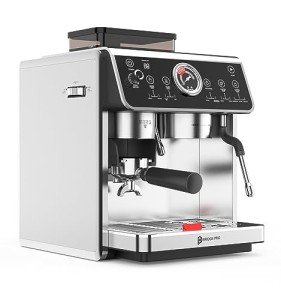Energy-Efficient Espresso Machines: A Comprehensive Guide
On the planet of coffee enthusiasts, espresso machines are frequently concerned as important appliances for brewing rich, fragrant coffee. However, the energy consumption related to these machines can result in increased energy costs and environmental issues. As consumers end up being more eco-conscious, energy-efficient espresso machines have become a popular choice. This article aims to explore the functions, advantages, and alternatives available in energy-efficient espresso machines, helping coffee fans make notified choices.
What Makes an Espresso Machine Energy-Efficient?
Energy-efficient espresso machines are developed to minimize energy usage while keeping ideal performance. Several features contribute to the energy effectiveness of these machines:
- Insulation: High-quality insulation assists maintain heat, reducing the energy required to keep optimum brewing temperatures.
- Smart Technology: Many modern machines are geared up with programmable settings that permit users to arrange developing times and change to standby mode when not in use.
- Quick Heat-up Time: Energy-efficient espresso machines typically use advanced heating technologies, such as thermoblocks or PID controllers, to heat water rapidly.
- Low Wattage: Machines that run at lower wattages consume less energy in general, making them more effective.
- Auto Shut-off: Automatic shut-off features make sure that the machine shuts off after a certain duration of inactivity, more reducing energy waste.
Benefits of Energy-Efficient Espresso Machines
Purchasing an energy-efficient espresso machine can use a number of benefits:
- Cost Savings: Over time, lower energy usage can result in minimized electricity costs.
- Environmental Impact: Using less energy lowers carbon footprints, making these machines a more sustainable option for ecologically conscious customers.
- Enhanced Performance: Many energy-efficient models likewise use remarkable developing innovations, resulting in better-tasting espresso.
- Toughness: Typically, energy-efficient machines are built with high-quality elements, leading to greater durability.
Functions to Consider
When choosing an energy-efficient espresso machine, a number of features need to be taken into consideration:
- Type of Machine: Options include manual, semi-automatic, and completely automatic models, each with varying degrees of user control and automation.
- Brew Quality: Look for machines that use high-quality developing systems to guarantee optimal taste extraction.
- Maintenance: Some machines have self-cleaning features that can save energy and effort in maintenance.
- Capacity: Depending on individual or family size, machine capability can affect energy usage, with larger machines often requiring more power.
Popular Energy-Efficient Espresso Machines
The marketplace uses a range of energy-efficient espresso machines accommodating various requirements and preferences. Below are some significant models:
| Brand | Model | Secret Features | Energy Consumption |
|---|---|---|---|
| Breville | Barista Express | Integrated grinder, PID temperature control, quick heat-up. | Low |
| DeLonghi | EC155 | Compact size, simple to use, durable build. | Moderate |
| Rancilio | Silvia | Durable style, outstanding temperature stability, and has a low environmental effect. | Moderate |
| Gaggia | Classic | Reliable manual operation, durable brass components, and efficient steaming capability. | Low |
| Jura | E8 | Completely automatic, smart functions, and a removable brew group for simple cleansing. | Low |
Tips for Optimal Energy Efficiency
Aside from selecting an energy-efficient design, consumers can adopt several practices to make the most of energy performance:
- Preheat: If your machine has a preheating function, use it to guarantee that the optimal temperature level is reached quickly before brewing.
- Shut off After Use: Always shut off the machine after brewing or make use of machines with auto shut-off features.
- Routine Maintenance: Keep the machine properly maintained to ensure it operates effectively and successfully.
FAQs About Energy-Efficient Espresso Machines
1. Are energy-efficient espresso machines more pricey?
While the initial financial investment might be greater for energy-efficient designs, the long-lasting savings on electrical energy expenses can offset the initial cost. Furthermore, lots of energy-efficient machines featured sophisticated features that enhance the brewing experience.
2. How do I know if an espresso machine is energy-efficient?
Search for indications such as Energy Star accreditation, user reviews, and specs concerning wattage and heat-up time. Machines with specific functions focused on lowering energy intake are generally created for better efficiency.
3. Can I use an energy-efficient espresso machine for other coffee designs?
Many energy-efficient espresso machines provide versatility, enabling users to brew different coffee styles beyond espresso, such as lattes and cappuccinos, by including steaming capabilities.
4. Do energy-efficient designs sacrifice quality for efficiency?
Not always. Lots of energy-efficient espresso machines are equipped with high-quality developing innovation that can improve taste extraction while minimizing energy usage.
5. What upkeep is required for energy-efficient espresso machines?
Regular upkeep includes cleaning the machine, descaling when essential, and occasionally checking seals and gaskets to make sure optimum efficiency and energy efficiency.
Energy-efficient espresso machines represent a best mix of efficiency, savings, and environmental responsibility. By thinking about numerous functions, advantages, and brands, consumers can select a model that suits their distinct choices while contributing favorably to the environment. As Espresso Maker Online towards sustainable living grows, the appeal of energy-efficient appliances, consisting of espresso machines, is most likely to continue its upward trajectory, providing coffee enthusiasts a guilt-free method to enjoy their day-to-day dose of espresso.

